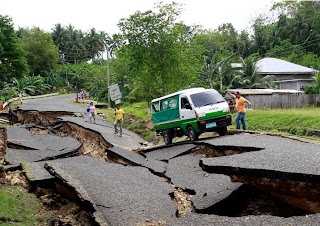Philippines gears up for big tremor

 It's nice to hear that many people were spared from the wraths of a big tremor that hit eastern Visayas and a portion of Mindanao in the Philippines. However, the vestiges of cracks along the roads and some buildings in Samar Island, were testament to nature's fury.
It's nice to hear that many people were spared from the wraths of a big tremor that hit eastern Visayas and a portion of Mindanao in the Philippines. However, the vestiges of cracks along the roads and some buildings in Samar Island, were testament to nature's fury.
Volcanologists claimed the earthquake, measuring about 7.2 in the richter scale, took place in the deepest part of the Pacific Ocean. Had it occurred onshore, there's no doubt that it could have destroyed more buildings and other infrastructures. At this writing, people are still feeling the quake's aftershocks, and they have expressed fear that a tsunami might come next.
According to Wikipedia, the Philippines lies within the Pacific Ring of Fire, which causes the country to have frequent seismic and volcanic activity.
The Philippine Institute of Volcanology and Seismology (PHIVOLCS) said the earthquake was caused by movement on a previously undiscovered fault. Although this was already discovered by private geologists hired by the local government in Negros Occidental, after the province was hit the hardest in 1948.
While the people in Samar and Surigao provinces are taking extra precautions to prepare for whatever eventualities, another tremor hit Costa Rica in South America, resulting to heavy destructions.
Atty. Francis Tolentino, chairman of the Metro Manila Development Authority (MMDA), said in a television interview that MMDA personnel are gearing up to prepare for the worst to come.
Tolentino's only worry is when the earthquake will come in the dead of night, when everybody is sleeping. "That's the worst that could happen," he said. However, he disclosed that the MMDA personnel are ready and prepared. In fact, the MMDA has already identified infrastructure projects that needed attention should any tremor occur onshore.
The strongest earthquake that hit the Philippines was in the 70s. Baguio City, the summer capital of the Philippines, was transformed into a cynosure of destructions. And it took days before a number of people, some dead and others gasping for breath, when they plucked out from the building's rubbles and debris.
As this developed, a group of independent architects and civil engineers explained that buildings constructed during the Spanish period have the capability to withstand the strongest tremor that could hit the country. They said that these old buildings are much stronger than the newly constructed ones.
For example, the University of Sto. Tomas is more than four centuries old. Yet, it has withstood the impacts of many strong earthquakes that hit the Philippines. Likewise, the Manila Cathedral in Intramuros, Manila, is still around, having been constructed many centuries ago. The old Catholic churches around the country can attest to this engineering wonders.
What exactly were the secrets of the Spanish architects and engineers in constructing these buildings, nobody knows? The only sure answer was that Spanish engineers at that time used a special kind of concrete adhesives that they harness from the resources of the seas to serve as plaster cement for building constructions.


Comments